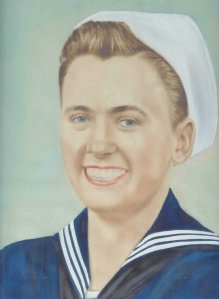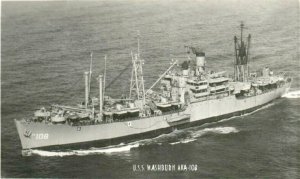Intermission Stories (8)
I have been attempting to show different facets of the military and how each one connects to complete a single mission at hand Jobs that are not spoken of very often. This following story is from the U.S. Navy, and a man who operated the little-talked about LSTs.
George Wayne Curtis
George Curtis was born in Champaign, Illinois in 1931 and went into the Navy in 1951. When he got to San Diego, he received more training and then was assigned to the USS Andromeda to ship to Japan. Once in Yokasuka, Curtis was ordered to the LST 1090, that would become his main ship. He made Quartermaster 3rd Class and did navigation chart work and learned how to use the semaphore flags, flash lights, etc. He said he was a cross between that and a signalman.
Curtis received more training at Pusan, Korea on loading, off loading, tanks and the LCVPs. (Landing Craft, Vehicle Personnel), for going ashore on leave. During his enlistment, he served in the Naval Amphibious Forces on: USS Andromeda AKA 15, USS LST 1090, USS Washburn AKA 108 and the USS LST 772. The 1090 was in the follow-up behind the initial landings in Inchon. One of his duties was navigation and assist in trying to get into the channel. “It is treacherous particularly because you could only get into that channel at certain times because of the high tide, and that tide is very high.”
“We did have some Marines that were cut off at Inchon. They directed us to come in with the LST and beach it to get them. We had to get them out because the Koreans were coming down on them. We picked them up, backed off and went on down the river.” Later on during the war, Curtis remembered picking up prisoners of war at Inchon and taking them to Koje-do Island. There were several hundred prisoners on board, each trip and they had to be fed due to the distance. (A day or two sailing.) “We also carried some war criminals. We brought them back separately. They were actually separated from the other prisoners. They were criminals that had decapitated 6 Americans.”
After the Armistice, the prisoners were brought to Pusan. “Some did not want to be repatriated. They refused to come out of the compounds and that became a problem. We had to drag them out.” Shortly after this, Curtis was transferred to the USS Washburn AKA 108 (Auxiliary Cargo Attack ship) shipping fuel oil to Point Barrow, Alaska.
From there, Curtis went to the LST 772 and headed back to Korea and then Indochina where he participated in evacuating French paratroopers, French Foreign Legion troops and civilians out of what would become North Vietnam. On one trip, a refugee woman went into labor. The sailors built a birthing room behind a curtain and the child was born aboard the LST.
George Curtis flew back to the States in November 1953 and entered the University of Illinois for spring semester 1954. The last line of his memoir, also found at Korean War Educator, was: “It has been a good life.”
Click on images to enlarge.
##########################################################################
Vietnam Memorial –
On 29 March 2014 in Austin, Texas, a new 14′ monument was unveiled on the Texas Capital grounds to represent the appreciation for the sacrifices made by Vietnam Veterans. Gov. Rick Perry’s dedication coincided with an event celebrating the 41st anniversary of the last US troops leaving South Vietnam. Approximately a half-million Texans served in that war, with more than 3,400 KIA and 105 still missing in action to this day.
###########################################################################
Royal Australian Air Force –
The RAAF celebrated their 93rd birthday on 31 March 2014! I would like to wish them all a very happy belated birthday wish and sincere THANK YOU for their service. They have a fantastic history behind them.
############################################################################
Farewell Salutes –
Donald Buckius – Lorton, VA; US Navy (Ret. 30 years) USS Wisconsin & Dehaven
Douglas R. Coutts – Toronto, Canada; Royal Canadian Navy, WWII
Cecil A. Edge – Hamilton, NZ; Royal New Zealand Air Force # 428360, Cpl., WWII
Ronald “Red” Gunderson – Everett, MA; US Army, Korea
Michael Ryan Kennedy – Boston, MA; USMC, Sgt., Iraq Campaign (Boston FD Engine 33 – 9 alarm fire)
David S. Light – Brooklyn, NY & Delray Bch, FL; US Army, WWII
Walter Maes – Spokane, WA; US Coast Guard, WWII
Edmond Maurice Murphy – Oklahoma City, OK; US Army, WWII, 189th Infantry, 45th Thunderbird Div, ETO
Laura T. Vogt – Winchester, VA; US Navy (WAVE), Chief Yeoman, WWII
#############################################################################
Posted on April 3, 2014, in Korean War, Uncategorized, WWII and tagged family history, History, Military, Military History, Navy, nostalgia, Tributes, veterans, Vietnam, war. Bookmark the permalink. 48 Comments.
















Thanks for a great interesting informative post as usual.
The story of the war criminals would be an interesting follow up
to ascertain the circumstances surrounding the actual deaths of the six Americans.
Ian
LikeLike
Perhaps you could get into that time era of information, Ian?
LikeLike
Always enjoy your posts – entertaining and informative! Thanks for all the good reads.
LikeLike
I’m happy to hear you enjoy visits, Brent.
LikeLike
Another awesome piece of history! What a treasure! – Thank you also for highlighting our Royal Australian Air Force 🙂
ML
LikeLike
No problem, they fought – they share in the recognition! Even India, who refused to fight, played a role behind the scenes that many forget about.
LikeLike
Glad you are including the “minor roles,” GP. I’m not sure there is any such thing. No matter what the task, everyone who participates has an important role to play. –Curt
LikeLike
It is all a big network that firmly fits together – what would one section be without the other? A regular domino effect would develop. People don’t always find the support jobs as “glamorous”, but they are necessary for the network to exist – I’m very glad you are enjoying it, Curt.
LikeLike
Love that line–‘it has been a good life’. There’s not much that compares to the military world, especially when we’re at war. Every other job pales. I’m glad he saw it that way.
LikeLike
I’m glad you noticed that. As I read the complete article on him, I felt the same thing and hoped I hadn’t lost it by condensing the story. Thank you.
LikeLike
Your posts are always so respectful and informative. I especially appreciate the Farewell Salutes. I try to take a moment to read each name and offer silent thanks.
LikeLike
THAT is very much appreciated. I hope one day if a descendant of theirs googles the name, they will know that some one was thinking of their uncle, father, or whatever. I try to keep my posts free of my own opinion (unless otherwise specified) and at ALL times try to show respect to all. Thanks, Cindi, I appreciate your comment.
LikeLike
Thanks for telling these personal stories. Interesting to see the role different people played in the war and how it affected their lives.
LikeLike
No body usually hears about the support people or what some consider “minor” roles in a war, but it takes a lot of different jobs to get the work done.
LikeLike
Another less spectacular but most interesting service record.
LikeLike
I was very happy to find these stories. Thanks for coming by!
LikeLike
Interesting 🙂
LikeLike
Thank you, I hope you’ll continue to read.
LikeLike
Glad that you are posting stories of the lesser know vocations.
I wonder whether you have any stories on logistics operations – battles are won or lost mostly on getting men and material to the right spot on time AND keeping them adequately supplied.
I would love particularly to read detailed (well, at least in some depth) logistics plans and execution of these plans.
Don’t go out on a limb – but only if you have these stories readily available.
LikeLiked by 1 person
I’ll check the files – no problem. I was hoping I’d get some suggestions.
LikeLike
I believe I located a story you might like and basic information on logistics. This might have to be a two-part story or a long one, I’ll see what I can do about it. In the meantime I located a site that might prove very interesting to you, but is much too long for me to condense for here – give it a try if have the time.
Click to access MLKW.pdf
LikeLiked by 1 person
Thank you and truly appreciate this link. I’ve book marked and will read through at leisure – at first glance, it’s exactly what the doc ordered 🙂
LikeLike
It amazed me that I actually found that, hope it turns out to be right, Eric.
LikeLike
I love the portrait at the top, so fresh. SD
LikeLike
Glad you could stop by, Sandra.
LikeLike
Reading the post, a thought came to my mind: “What a good life – filled with direction and purpose” and then I read “i has been a good life” – funny how perception works 🙂 By the way I think there’s a spelling mistake in text at second line under “radio shack” photo: should that be “the Koreans were coming” instead of “the Koreans wee coming” 😀
LikeLike
Good catch, Ina. I have edited the error and thank you!
LikeLike
XX
LikeLike
I don’t know what XX means, but I appreciate you stopping in, Ina.
LikeLike
XX means friendly greetings with one kiss on each cheek 😀 used in Europe, Australia and other countries, Cheers
LikeLike
Thank you, Ina. I never knew this. Wow, do I feel red-faced!
LikeLike
A personal story such as this brings the bigger picture alive. Fine, fine post.
LikeLiked by 1 person
Thank you, Mike. I agree. Just listing statistics makes it all too impersonal.
LikeLike
An amazing story. Decapitation seems like the way of that part of the world. In America we rarely hear of such a thing.
LikeLike
Interesting point, Pierre. I wonder how that practice came about (the guillotine?)
LikeLike
That was basically the French who thought it was less cruel because it was fast. To my knowledge no one ever survived. The French Revolution decapitated men, women and children. Pathetic.
LikeLike
The ancient Irish used to decapitate fallen enemies as a rule and keep the heads to present as trophies . I suppose decapitation was a common ancient practice . Good question . During the Middle Ages , heads were stuck on city gates as warnings to behave yourself while in town .
LikeLike
So, I take it, none of us knows the origin of decapitation? (Maybe that isn’t a bad thing!) 😕
LikeLike
Another great post. And the RAAF continue to do a great job, this time searching for the missing Malaysian Airlines plane.
LikeLiked by 1 person
I wonder if the truth about what happened on that plane will ever come to light. Thanks for reading and commenting – and most of all – thanks for posting again.
LikeLike
🙂
LikeLike
Thanks!
LikeLike
About the aircraf carrier… Probably an Essex Class.
http://en.wikipedia.org/wiki/Category:Korean_War_aircraft_carriers_of_the_United_States
LikeLike
Thanks, Pierre. You’re one of the reasons I noted that it was unknown – I just knew you’d help, friend.
LikeLike
I tried looking at the plane markings on the deck for more clues.
Always fun to search for more information like R.M. Bolzano!
LikeLike
I know what you mean, but I’m not as good at it as you – that’s for sure!
LikeLike
Thank you, Ian.
LikeLike
Pingback: FEATURED BLOGGERS REPORT: Eye Witness Account – Edward Dager By Pacific Paratrooper #AceHist oryDesk reports | ' Ace Worldwide History '